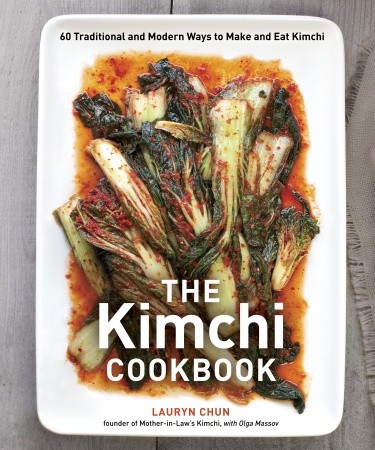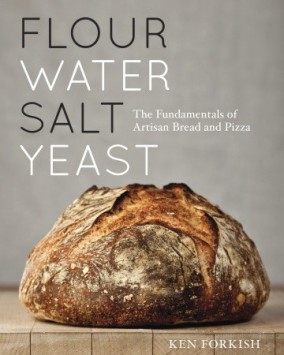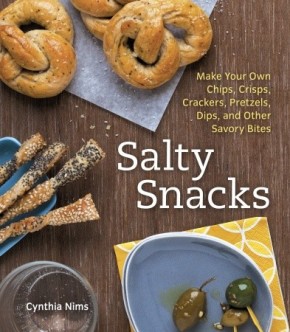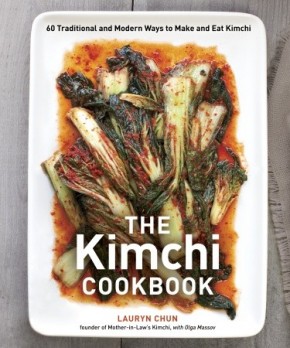The Kimchi Cookbook60 Traditional and Modern Ways to Make and Eat Kimchi
Based on Korea’s legendary condiment, Mother-in-Law’s Kimchi is taking America by storm with its vibrant, versatile balance of flavor and just the right amount of spice. Making kimchi is the next frontier for anyone who enjoys DIY food projects, and homemade kimchi is a must-have for connoisseurs of the beloved Korean pickle.
Following traditional kimchi-making seasons and focusing on produce at its peak, this bold, colorful cookbook walks you step by step through how to make both robust and lighter kimchi. Lauryn Chun explores a wide variety of flavors and techniques for creating this live-culture food, from long-fermented classic winter kimchi intended to spice up bleak months to easy-to-make summer kimchi that highlights the freshness of produce and is ready to eat in just minutes.
Once you have made your own kimchi, using everything from tender and delicate young napa cabbage to stuffed eggplant, you can then use it as a star ingredient in Chun’s inventive recipes for cooking with kimchi. From favorites such as Pan-Fried Kimchi Dumplings and Kimchi Fried Rice to modern dishes like Kimchi Risotto, Skirt Steak Ssam with Kimchi Puree Chimichurri, Kimchi Oven-Baked Baby Back Ribs, and even a Kimchi Grapefruit Margarita, Chun showcases the incredible range of flavor kimchi adds to any plate.
With sixty recipes and beautiful photographs that will have you hooked on kimchi’s unique crunch and heat, The Kimchi Cookbook takes the champagne of pickles to new heights.
Lauryn Chun is the founder of Mother-in-Law’s Kimchi, a line of artisan kimchi based on an original recipe from Jang Mo Jip (“Mother-in-Law’s House”), her mother’s beloved restaurant in Garden Grove, California. From her mother’s kitchen to work in the fine dining and wine industries, Chun’s deep love for food and wine led her from the Rhône Valley and Spain to Italy’s hills, where she worked harvesting grapes. While living in New York City, she recognized the beauty of Korea’s tradition of handcrafted kimchi, which inspired her to launch Mother-in-Law’s Kimchi in 2009.
Olga Massov is a Brooklyn-based food writer whose blog, sassyradish.com, has been recognized by Serious Eats, Saveur, theKitchn.com, Smithsonian, and the Huffington Post, among others. Her love of kimchi and fish sauce knows no bounds.
Lauryn Chun
Lauryn Chun author of the Kimchi Cookbook talks to us about what she wants you to know about kimchi.
Is there one (or more ) big misconception(s) that people have about kimchi that you would like to set straight?
Kimchi is not just cabbage and not just spicy. Good kimchi is something that is in balance in taste and texture — not too salty or spicy. The origin of the word kimchi means “salted vegetables’ and is a technique of brining vegetables – ‘pickling’ – in its most natural state using salt & seasonal vegetables to preserve it. The breath and scope of kimchi is diverse with more than hundred foundational recipes of kimchi that vary from regions all over Korea as each family has their own prized recipe and style of kimchi making. There is a saying that no two kimchi tastes the same.
What advice or suggestions to the kimchi newbie?
Don’t be scared by the process of fermentation. The bubbling is part of the lactic (beneficial) bacteria that is the first step in fermentation. It is the easiest way to use salt to preserve your vegetables and allow for time to do its fermentation magic. Remember that kimchi is always changing with time, what you taste after the first few days will change in another week or months to come. This is the joy of kimchi making which is unique to raw, active, live fermentation and probiotics (good bacterias).
Can you tell us a little about the writing process and experience for this book?
When I set out with the idea of writing a cookbook about kimchi, I didn’t realize how personal it was going to be. Given that kimchi is the single most important culinary dish of Korea, it became a bigger project than I had originally anticipated. There is probably no other dish that is the national identity of a country and culture like kimchi. It gave me reverence for what it means to be Korean and also to have a much deeper understanding of the multiple facets of fermented flavor throughout Korean cooking. The role that kimchi plays eaten with every meal as a condiment and in cooking gave me a full scope of the versatility and heritage of this food that is deeply rooted in thousand years of tradition. It was also important for me to explain kimchi in context as a modern, contemporary pickling process in the American/Western foods and not something that is exclusively Korean.
Would you say that kimchi is getting, for lack of a better phrase, ‘more mainstream’?
I would say that there is an exciting level of awareness about kimchi as a raw, fermented foods in America, not merely a trend but an awareness. It’s wonderful to be a part of change in the way Americans are more open to flavors and spice. There is an awakening about our relationship with vegetables and food towards a healthfulness and mindfulness. Kimchi is a fantastic way to enjoy a vast array of vegetables at their seasonal peak – home made kimchi is one of the most economical and healthful way to add flavor and healthy probiotics to family meals.
Can you tell us a little about Mother-in-Law’s Kimchi?
I founded Mother-in-Law’s Kimchi in 2009 with a goal to share an authentic, artisanal traditional kimchi in national specialty markets. The kimchi recipe hails from my mother’s 25 year old restaurant called “Mother-in-Law’s House” in Garden Grove, CA and homage to her. Because of my love of fine food & wine, I wanted to be able to share the tradition of kimchi much in the same context as a fine, hand crafted, fermented foods the way Western cultures understand wine, cheese or beer making.
What are you working on now?
Continuing to spread the good word on kimchi!
~~~~~~~
©2012 Booksaboutfood.com
“If you thought that cabbage was the be-alland end-all of kimchi, Lauryn Chun will quickly prove you wrong. From the quick satisfaction of Cucumber and Chive Kimchi to long-aged bachelor radishes, this book will have you fermenting every season’s vegetable crop, and then show you inventive ways to cook with what you make.”
—Willy Blackmore, Los Angeles editor of TastingTable.com
“As an enthusiastic kimchi eater, I’ve long wished for someone to teach me how to create all those interesting, zippy flavors at home. The Kimchi Cookbook is just the thing for home canners who want to take their food preservation beyond traditional jams and vinegar pickles. Lauryn Chun’s recipes for tangy, bright, and bubbly kimchi are approachable and make a world of fermented foods seem firmly within our grasp.”
—Marisa McClellan, author of Food In Jars and creator of FoodInJars.com
Butternut Squash Kimchi with Lacinato Kale and Pine Nuts,
French Breakfast Radish Kimchi, Grilled MILKimcheeze Sandwich
Butternut Squash Kimchi with Lacinato Kale and Pine Nuts
Hobak Kimchi (Contemporary)
Prep: 20 minutes › Brine: 40 minutes › Fermentation: 2 to 3 days
Makes 4 cups (4 to 6 servings)
11/2 pounds butternut squash (about 1/2 of a small squash), peeled, cored,
quartered, and cut into 1/8-inch-thick slices
41/2 cups water
2 tablespoons kosher salt, plus 21/4 teaspoons
2 cups finely chopped Lacinato kale (about 1/2 bunch)
2 tablespoons Korean chile pepper flakes
1 teaspoon chopped garlic
1/2 teaspoon peeled, finely grated fresh ginger
2 tablespoons pine nuts
1/2 cup Mushroom Broth (page 26; optional)
1 teaspoon sugar
In a large bowl, mix the squash with 4 cups of the water and the 2 tablespoons salt. Set aside for 40 minutes. Drain the brine and allow the squash to dry in the colander.
Meanwhile, in a medium colander, toss the kale with 2 teaspoons of the salt and set aside for 15 minutes. Using the colander, rinse off any excess salt with water, then set the colander over a bowl and allow the remaining water to drain into the bowl. Set aside the water that drains off the rinsed kale.
In a large bowl, combine the squash and kale with the chile pepper flakes, garlic, ginger, and pine nuts and toss until the seasonings are well incorporated. Place the mixture into a quart-size container with a tight lid. Swirl the water that drained off the kale and add 1/2 cup water and the remaining 1/4 teaspoon salt. Or, use mushroom broth in place of the water and salt. Add the sugar and stir to dissolve.
Ladle the mixture into the container until one-third of the contents are covered.
Allow the mixture to ferment at room temperature for 2 to 3 days. Refrigerate and consume within 1 month.
French Breakfast Radish Kimchi
Prep: 1 hour › Brine: 20 minutes › Fermentation: 1 day
Makes 4 cups (4 to 6 servings)
Brine
11/2 to 2 pounds French Breakfast radishes or table radishes, with their stems on (stems optional)
11/2 tablespoons kosher salt
Seasoning Paste
1/4 cup Mushroom Broth (page 26) or water
2 tablespoons Korean chile pepper flakes
1 teaspoon peeled, finely grated fresh ginger
1/2 teaspoon minced garlic
1/2 teaspoon sugar
In a large bowl, thoroughly wash the radishes in 3 to 4 changes of water. Drain. Trim any unsightly ends and tops and cut the radishes in half. In another large bowl, toss the radishes with the salt. Let stand for 20 minutes.
To make the seasoning paste, in a small bowl, combine the broth, chile pepper flakes, ginger, garlic, and sugar. Set aside.
Drain the radishes in a colander set over a bowl, reserving the brined juice. Rinse any excess salt off the radishes and let drain for another 15 minutes.
In a large bowl, combine the radishes with the seasoning paste and toss until evenly coated. Pack the radishes into a quart-size jar. Pour the reserved brining liquid into the bowl that was used to coat the radishes with the seasonings, and swirl the liquid around to capture any leftover seasonings. Pour into the jar, cover with a lid, and let sit at room temperature for 1 day. Refrigerate and consume within 1 week.
Grilled MILKimcheeze Sandwich
Prep: 5 minutes › Makes 4 servings
1/4 cup unsalted butter
8 (1/2-inch-thick) slices country-style bread
16 ounces cheese, such as Havarti, Monterey jack, or Swiss, sliced thick
1 cup any napa cabbage kimchi, coarsely chopped
Heat the griddle or a large skillet over medium-low heat.
Butter the slices of bread on one side and place them on the skillet, butter side down (you may need to do this in batches). Distribute the cheese evenly on half of the bread slices and cook until slightly melted.
Place the kimchi on top of the cheese, top with the remaining toasty bread slices, and cook for 1 minute more, or until the cheese is completely melted and the bread is toasted golden brown.
Using a spatula, gently flip the sandwich and cook for 1 minute longer. Remove from the pan and cut each sandwich in half for easier handling. If working in batches, repeat with the remaining ingredients. Serve hot.
Photo credit: Sara Remington © 2012
Reprinted with permission from The Kimchi Cookbook: 60 Traditional and Modern Ways to Make and Eat Kimchi, by Lauryn Chun, copyright © 2012. Published by Ten Speed Press, a division of Random House, Inc.Photo credit: Sara Remington © 2012














Leave a Reply